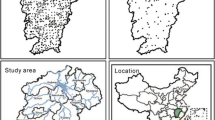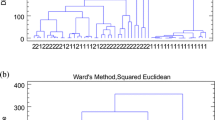Abstract
The relationship between the mortality of cervical cancer and soil trace elements of 23 regions of China was investigated. A total of 25 elements (i.e., Na, K, Mg, Ca, Sr, Hg, Pb, B, Tm, Th, U, Sn, Hf, Bi, Ta, Te, Mo, Br, I, As, Cr, Cu, Fe, Zn, and Se) were considered. First, 23 samples were split into the training set with 12 samples and the test set with 11 samples. Then, a combination strategy called genetic algorithm–partial least squares (GA–PLS) was used to pick out five important elements. i.e., Br, Ta, Pb, Cr, and As. Afterwards, the classic partial least squares (PLS) model and least square support vector machine (LSSVM) model were developed and compared. The results revealed that the SVM model significantly outperforms the PLS model, indicating that the combination of GA–PLS and LSSVM can serve as a potential tool for predicting the mortality of cancer based on trace elements.






Similar content being viewed by others
References
WHO (2002) National cancer control programmes: policies and managerial guidelines, 2nd edn. World Health Organization, Geneva
Beral V et al (1994) Cervical cancer. Cancer Surv 19–20:265–285
Anttila A et al (1999) Effect of organized screening on cervical cancer incidence and mortality in Finland, 1983-1995: recent increase in cervical cancer incidence. Int J Cancer 83:59–65
Patnick J (2000) Cervical cancer screening in England. Eur J Cancer 36:2205–2208
Zhang ZY, Zhou HL, Liu SD, Harrington P (2006) An application of Takagi-Sugeno fuzzy system to the classification of cancer patients based on elemental contents in serum samples. Chemom Intell Lab Syst 82:294–299
Douglas MT (2003) The importance of trace element speciation in biomedical science. Anal Bioanal Chem 375:1062–1066
Tan C, Chen H, Xia CY (2009) Early prediction of lung cancer based on the combination of trace element analysis in urine and an Adaboost algorithm. J Pharm Biomed 49:746–752
Tan C, Chen H, Xia CY (2009) The prediction of cardiovascular disease based on trace element contents in hair and a classifier of boosting decision stumps. Biol Trace Elem Res 129:9–19
Frisk P, Ola Darnerud P, Friman G, Blomberg J, Ilbäck NG (2007) Sequential trace element changes in serum and blood during a common viral infection in mice. J Trace Elem Med Biol 21:29–36
Gurusamy K, Davidson BR (2007) Trace element concentration in metastatic liver disease—a systematic review. J Trace Elem Med Bio 21:169–177
Zhai HL, Chen XG, Hu ZD (2003) Study on the relationship between intake of trace elements and breast cancer mortality with chemometric methods. Comput Biol Chem 27:581–586
Han CZ, Jing JX, Zhao XW, Guo JG, Zheng SM, Du LL (2003) Serum and tissue levels of six trace elements and copper/zinc ratio in patients with cervical cancer and uterine myoma. Biol Trace Elem Res 94:113–122
Leardi R, González AL (1998) Genetic algorithms applied to feature selection in PLS regression: how and when to use them. Chemom Intel Lab Syst 41:195–207
Lavine BK, Davidson CE, Moores AJ (2002) Genetic algorithms for spectral pattern recognition. Vib Spectrosc 28:83–95
Leardi R, Seasholtz MB, Pell RJ (2002) Variable selection for multivariate calibration using a genetic algorithm: prediction of additive concentrations in polymer films from Fourier transform-infrared spectral data. Anal Chim Acta 461:189–200
Ding Q, Small GW (1998) Genetic algorithm-based wavelength selection for the near-infrared determination of glucose in biological matrixes: initialization strategies and effects of spectral resolution. Anal Chem 70:4472–4479
Wold S, Sjöström M, Eriksson L (2001) PLS-regression: a basic tool of chemometrics. Chemom Intel Lab Syst 58:109–130
Höskuldsson A (1988) PLS regression methods. J Chemometr 2:211–228
Gestel T, Suykens J, Baesens B, Viaene S, Vanthienen J, Dedene G, Moor B, Vandewalle J (2004) Benchmarking least squares support vector machine classifiers. Machine Learn 54:5–32
Suykens JAK, Vandewalle J (1999) Least squares support vector machine classifiers. Neur Proc Let 9:293–300
Suykens JAK, Brabanter J, Lukas L, Vandewalle J (2002) Weighted least squares support vector machines: robustness and sparse approximation. Neurocomputing 48:85–105
China Environmental Monitoring Centre (1990) Chinese soil element background values. China Environmental Science Press, Beijing, pp 330–483, in Chinese
Schrauzer GN (2006) Interactive effects of selenium and chromium on mammary tumor development and growth in MMTV-infected female mice and their relevance to human cancer. Biol Trace Elem Res 129:281–292
Schwartz MK (1975) Role of trace elements in cancer. Cancer Res 35:3481–3487
Walboomers JM, Jacobs MV, Manos MM (1999) Human papillomavirus is a necessary cause of invasive cervical cancer worldwide. J Pathol 189:12–19
Nogrady T, Weaver DF (2005) Medicinal chemistry: a molecular and biochemical approach. Oxford University Press
Acknowledgments
This work was supported by Sichuan Province Science Foundation for Youths (09ZQ026-066) and Scientific Research Startup Fund for Doctor, Yibin University (2008B06). We are very grateful to anonymous reviewers for their valuable comments and suggestions.
Author information
Authors and Affiliations
Corresponding author
Rights and permissions
About this article
Cite this article
Tan, C., Chen, H., Wu, T. et al. Modeling the Relationship Between Cervical Cancer Mortality and Trace Elements Based on Genetic Algorithm–Partial Least Squares and Support Vector Machines. Biol Trace Elem Res 140, 24–34 (2011). https://doi.org/10.1007/s12011-010-8678-1
Received:
Accepted:
Published:
Issue Date:
DOI: https://doi.org/10.1007/s12011-010-8678-1




